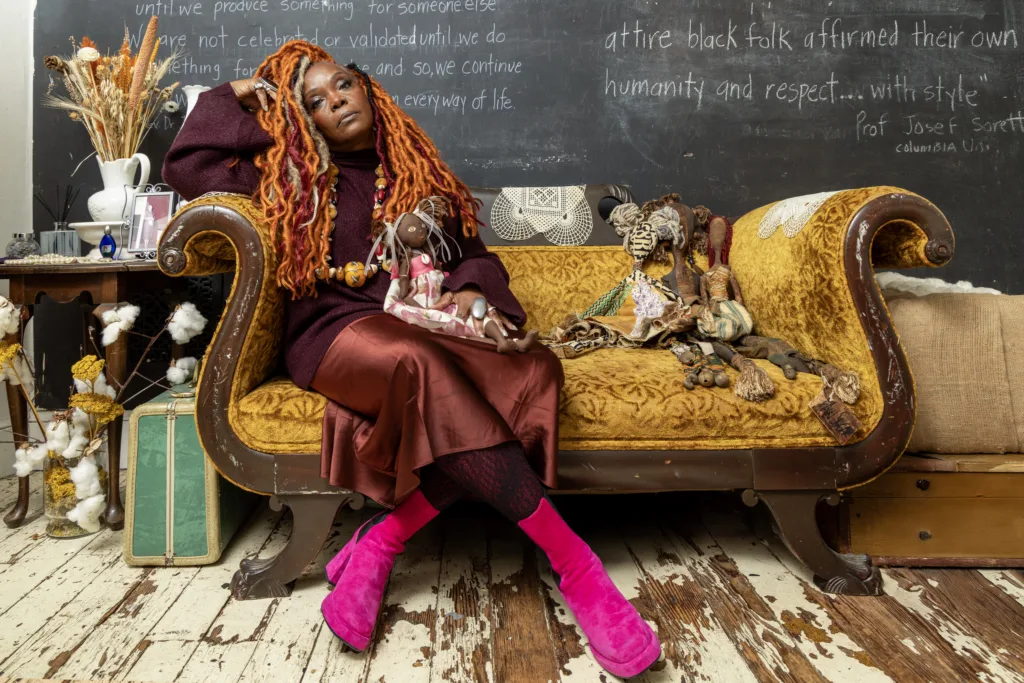
By Jeneen Owens
On an unassuming street in Germantown, a black art deco-patterned iron entryway welcomes me onto the stone and brick pathway, lined with statuesque pieces, that guides me into The Colored Girls Museum (TCGM).
Vashti Dubois, founder and executive director of the museum, invites me into her home. I am immediately taken in by her spirit, which says, “You are welcome here,” a feeling in the house’s bones.
The seeds for the museum were cultivated in the tumultuous soil of early trauma and devastating loss, which gave way to a healing journey that became a love letter to Black girls and Black women. According to her, she set out to create a space where Black women and girls feel comfortable.
Home Made
A twenty-four-year Philadelphia transplant, Dubois and her husband Albert relocated to the house on Newhall Street with their three children after 9/11. The trauma of the attack and New York City’s unsettledness played a huge role in the family’s move.
Dubois spent her formative years in Brooklyn, where – at the age of fourteen – she found herself
homeless. Her relationship with her mother was less than ideal, culminating with her mother’s decision that Dubois could no longer live in her home.
Afterward, everything she knew of ‘home’ lived in a black trash bag she would take with her from house to house. She set up her artifacts in temporary dwellings and created a sense of this home wherever she was. This was the first inkling of what was to become The Colored Girls Museum.
In school, she was shy and embarrassed at her transient state, believing everyone could see her “orphan-ness.” One of the few Black teachers at the school saw something in her and instructed her to join the theater program. She joined, thinking she’d go and learn how to act like she was not afraid.
Instead, she gained confidence in her talents and a new way to express herself. Cultivating her talent with theater led to further artistic endeavors that would also prove to be seeds for the museum. Another was her Women’s Work project at Wesleyan University, where she gathered on campus with girls of color to take over the living room of a special interest house, curating the home space with significant items and eventually performing as a group in those spaces.
Years later, she created and performed a show at the Philadelphia Fringe Festival “about a house that dresses up like a colored girls’ museum and then disguises herself as a bed and breakfast, because if people know she’s a colored girls museum, they might harm her.” She says she didn’t know where the idea came from at the time – it may have stemmed from her desire to run a bed and breakfast one day, or from her love of hosting people.
A Love Letter
The concept for creating a museum inside her home came from a couple of different ideas; one was the beauty created between two artists who found each other and decided to do life together.
Vashti and Albert met in junior high school but never dated. They found each other, twenty years later in 1996, on a Boston street corner. Al was an entertainer and musician who also worked as a foreclosure prevention specialist, helping people navigate the foreclosure process. The two went on their last first date nine months later and began their life together as a couple.
The couple opened their home to the community using their talent as artists, and the canvas of their home space. “I knew the house could perform… She’s a character.” Al’s working environment spawned the idea to stage their home as a foreclosure-themed art installation. The couple invited eight artists to tell foreclosure stories in each of the rooms in the home. Al was the Master of Ceremonies, leading visitors on a fifteen-minute guided tour of the peep show-style artists’ space. Everything in the home could be bid on except the people.
This was the first time that their house performed, and it gave the model for how the colored girls museum now runs. “The structure of the museum,” Dubois explains, “came from that show; the story of it came from being a girl, very young alone in the world.”
In March 2014, Vashti’s life was upended when Al died in a car accident, minutes from their home. Her grief threatened to take her life, and she was urged to make a choice, to do something. She chose to open her home again – this time to artists and Black women, to begin to heal in community.
“I did it to heal, but [also] to have the cover to heal. I opened my home and gave people a tour – it was a grief ritual. I was doing this for my healing; this was my healing work. This is the form that it took.” Dubois adds, “The healing work is in the house, the love of the family is in the house, the colored girl’s museum is a love story…”
Homecoming
Each room has a theme and, until recently, was only curated by women artists – one of the current installations was curated by a man in tribute to his grandmother. The pain management room is a speakeasy. There is a room dedicated to the legacy of Washer Women, and a room dedicated to showing older Black women in the future.
There are books everywhere. Every room I entered felt like a close sister friend, like a great-grandmother, like a mom, like home.
“Healing is like love; you actually have to show up everyday and practice love. It’s not transferable. You gotta show up the next day and do it all over again. Healing is not a finite event. There are so many things we are caring for that we are healing from,” Dubois said of recovery.
Vashti Dubois keeps this house because she wants Black women to visit and know that someone is expecting them and has prepared a space for them to be comfortable. She said that in naming the museum, “the concept of ‘colored’ came from [the] ways in which the world just colors on Black women and girls; just takes out its crayon and colors us whatever the hell it wants… TCGM is my love letter to ordinary colored girls.”
The Colored Girls Museum celebrated its ninth year in September 2024. You can make a plan to visit and experience the current offerings online at the website: https://www.thecoloredgirlsmuseum.com/visit
This article originally appeared in the 2024 Winter issue of Love Now Magazine with the theme of Healing. You can read more stories like Vashti’s here.










